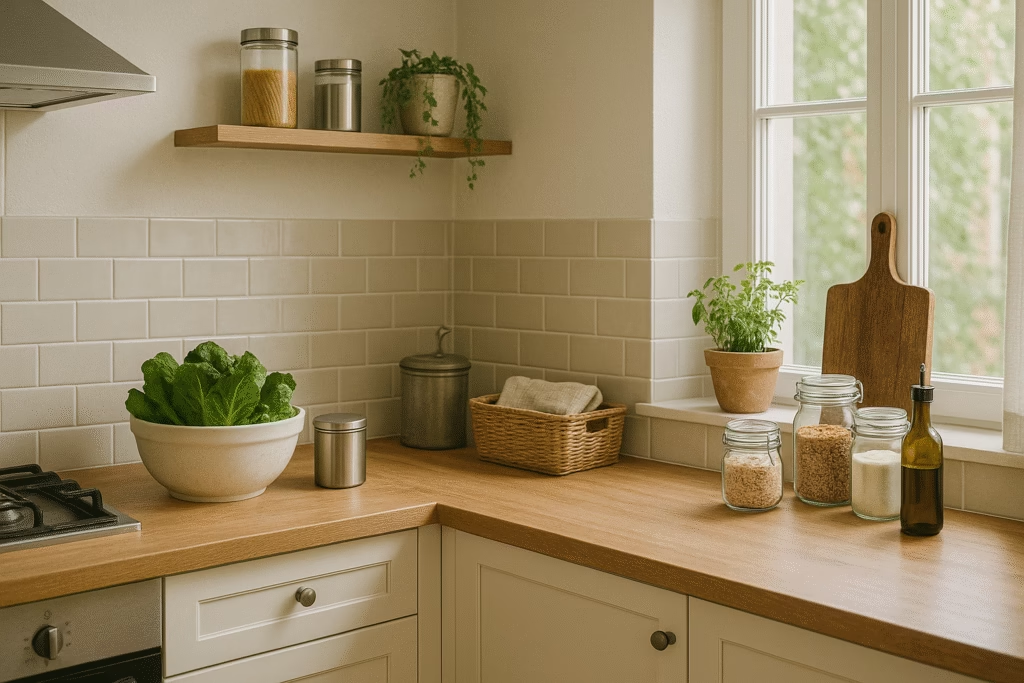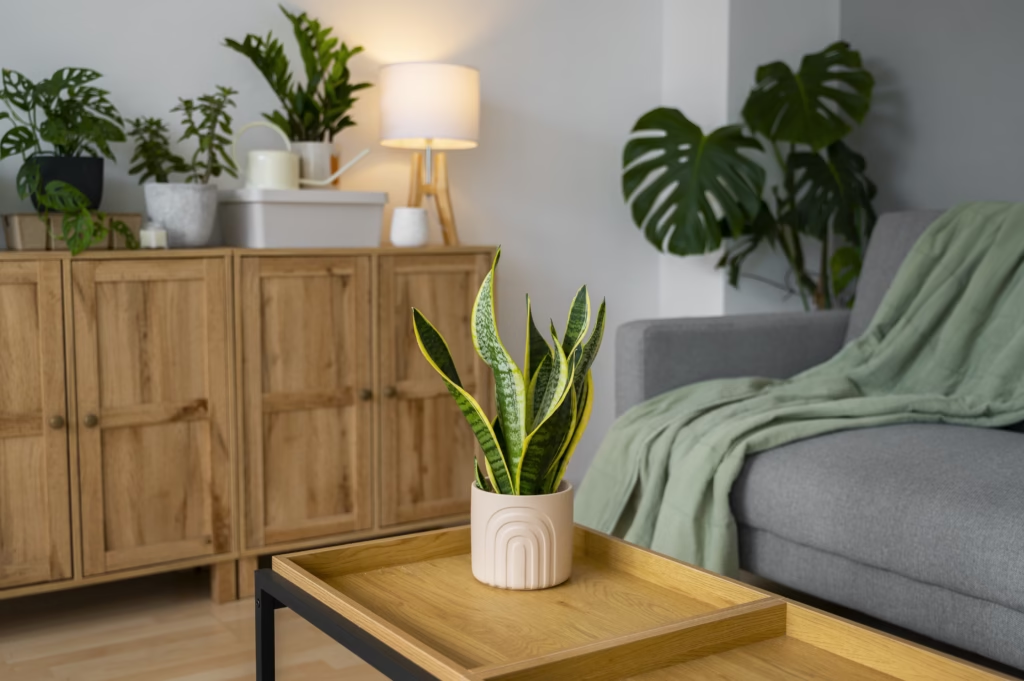An eco friendly home might sound like a big project, but it’s really about making simple changes in each room. Those small steps add up to a healthier space for you and better for the planet too.
You don’t have to change everything at once. This guide provides easy-to-follow tips for every room in your home.
Living sustainably becomes easier when taken one step at a time. Ready to get started? Let’s look at simple, green home tips room by room.

Before we go room-by-room, let’s take a look at some simple habits and ideas that will help make your whole home eco-friendly.
- Save Energy
Change your regular bulbs to LED lights. These consume much less power and last longer. Consider smart plugs, timers, or smart thermostats to turn off appliances and control heating/cooling when you’re not using them.
- Use water wisely
Small changes like fixing leaks, turning off faucets while brushing teeth and installing low-water showerheads can add up to significant water savings over time. Being mindful of water use saves both the environment and your bills.
- Choose safe materials
When updating your home, choose paint, furniture and cleaning products that don’t contain harsh chemicals. These safer options enhance indoor air quality while lowering pollutants.
- Cut down on waste
Follow the three R’s: reduce, reuse and recycle. Instead of using single-use plastic bags, containers, and bottles, go for reusable ones. Recycle items properly to keep waste out of landfills.
Making Every Room More Eco Friendly
Making your home greener doesn’t have to be overwhelming. Breaking it down room by room makes it easier and helps you focus on small changes that suit your lifestyle. Let’s start with the heart of the home: the kitchen, where even minor adjustments may make a big difference.
The kitchen
The kitchen is a big, energy and resource-intensive place, but small changes here really pay off.

- Reduce single-use plastic: Replace plastic wrap, sandwich bags and disposable containers with reusable options like plant-based wax wraps, glass containers or silicone bags.
- Use appliances wisely: Run your dishwasher only when it’s full. Use energy-efficient settings whenever possible. Cooking with a microwave or pressure cooker instead of a normal oven can save electricity.
- Start composting: Food scraps don’t have to be thrown into landfills. Composting is a simple method for converting trash into nutrient-rich soil for your plants.
- Choose eco-friendly cleaners: Many kitchen cleaners contain harsh chemicals. Using plant-based or homemade cleaning solutions reduces the amount of toxins in your home and the environment.
Bathroom
A lot of water and plastic trash build up quickly in bathrooms. But these are also one of the easiest places to bring environmentally friendly changes.
- Use low-flow fixtures: Apply low-flow showerheads and taps to reduce water consumption without reducing pressure. It is easy to apply them, and they can make a lot of difference in your water bill.
- Rethink your toiletries: Look for shampoo bar, refillable soap dispenser, bamboo toothbrush and plastic-free packaging.
- Be smart with water: Turn off the tap when brushing or shaving. Even such small habits save a lot of gallons of water every week.
- Choose natural cleaning products: Like the kitchen, your bathroom does not require harsh chemicals to stay clean. Choose a natural or self-made cleaner made of materials such as baking soda, vinegar and essential oil.
Laundry Room
The laundry room may not take up a clear space to be environmentally friendly, but in fact, it is one of the biggest wastes of energy and water in most homes. Small changes here can prove to be very helpful.
- Wash with cold water whenever possible: Your washing machine uses the majority of its energy to heat the water. As long as you are not dealing with stubborn stains, cold water works equally well for daily clothing and also helps to maintain the quality of clothes.
- Choose an energy-efficient washer and dryer: If you are going to upgrade, see the Energy Star-Recommended Equipment. These use much less water and electricity than older models.
- Line dry when you can: If you have space (even if the window has a drying rack), drying the clothes in the air saves electricity, and the clothes are less worn.
- Use an environmentally friendly detergent: Many detergents contain chemicals that can damage your skin and the environment. Choose detergents that are based on plants, biodegradable, and whose packaging is recycling or plastic-free.
- Skip the dryer sheets: The dryer sheet often contains synthetic aroma and chemicals. Instead, use woollen dryer balls – they are reusable, reduce static electricity and help in drying clothes quickly.
- Run only the full loads: Half-loaded water and energy wastage. Run full load for low load or use eco-friendly settings.
Bedroom
Even though the bedroom does not seem to be a great source of environmental impact, here you can do a lot to choose a more conscious option.
- Choose natural bedding materials: Look for sheets, duvet and pillow made from organic cotton, bamboo or linen. They are made in an airy, skin-friendly and durable way.
- Buy less, choose better: Instead of trendy decorations that become useless after a season, invest in timeless goods made of good quality materials, especially furniture. Certified is a better option than solid wood, MDF or fast furniture made of durable sources.
- Light with intention: Use LED bulbs and turn off the light if not needed. Apply blackout curtains to reduce the need for heating and cooling.
- Declutter sustainably: If you want to give a new look to your place, then donate or sell instead of throwing things away. When purchasing new goods, consider secondhand or desecable items to give new life to things.
- Skip synthetic fragrances: Scented candles and sprays often release chemicals that can harm indoor air quality. For a natural, cozy scent, try essential oils, plant-based candles, or simmering herbs and spices on the stove.
Living Room
This is the place where you probably spend most of your free time – reading, watching shows, hosting friends. It is also a place where environmentally conscious changes can be really useful.

- Choose durable furniture: If you are buying new furniture, consider furniture made of reclaimed wood, metal or natural fibres. Brands that use non-toxic adhesives and finishes are also worth seeing.
- Rethink decor: Choose the decorations of handmade, reused or nature-inspired, except for large-scale plastic decorations. Plants inside the house can improve air quality and illuminate your home.
- Control the use of electronic devices: To cut electricity use, group devices on a power strip and turn them off when they’re not in use. Also, choose energy-skilled models when upgraded.
- Maximum use of natural light: During the day, open the curtains and let the sunlight come into your house. This is an easy way to reduce electricity use as well as improve your mood.
- Low-VOC paints and finishes: If you are giving a new look to walls or floors, choose less or zero-VOC labels paint, varnish and finish. They release fewer chemicals into your home and environment.
Home Office
If you’re working or studying from home, your home office is part of your eco friendly home, so it’s worth finding a few ways to keep that space green too.
- Choose energy-efficient electronics: Choose laptops, monitors, and printers with good energy ratings. Turn them off completely instead of keeping them on standby when not in use.
- Go paperless whenever possible: Limit printing by adopting digital technology. Use apps, cloud storage, and note-taking tools to keep things organized to avoid paper waste.
- Use sustainable office supplies: Use recycled paper, refillable pens, and non-toxic ink. Avoid single-use plastics like disposable pens or plastic binders.
- Optimize lighting: To get the most natural light possible, place your desk close to a window. Use LED desk lamps instead of incandescent bulbs.
- Furniture with a Conscience: If you need a desk or chair, look for items made from sustainable materials or buy secondhand furniture. This cuts down on waste and keeps furniture out of landfills.
Entrances and Hallways
These often-overlooked spaces offer easy ways to boost your home’s eco-friendliness without much effort.
- Use sustainable, natural materials: Choose rugs and mats made of natural materials such as jute or coir. These last longer than synthetic options and break down more easily.
- Choose low-VOC paints: If you’re painting these spaces, use low or zero-VOC paints to improve indoor air quality.
- Plant plants: To enhance the air quality and create a pleasant atmosphere, place low-maintenance plants at the entrance.
- Smart lighting: Add motion sensors or timers to hallway lights to keep them from staying on unnecessarily.
- Keep it clutter-free: Use storage made from sustainable materials to organize shoes and coats. Keeping your space tidy can help lower stress and improve well-being.
Garages and Storage Areas
These spaces may not get much attention, but they are great places to practice eco-friendly habits that save resources and reduce waste.
- Organize to reduce waste: Keep things organized so you avoid buying duplicates or throwing out items when you can’t find them.
- Choose eco-friendly paints and sealants: If you’re painting or caulking floors or walls, choose low-VOC or water-based products to reduce harmful fumes.
- Recycle properly: Have bins to recycle cardboard, metals, and plastics. Make sure hazardous materials like batteries and paint are disposed of safely.
- Use energy-efficient lighting: Install LED bulbs to save electricity and consider motion-activated lights.
- Store chemicals safely: Keep cleaning materials, paint and other chemicals sealed and in proper containers to avoid leaks and contamination.
Outdoor Space
Your patio, balcony or yard can be a big part of your journey to an eco friendly home.
- Plant local species: Choose plants that grow naturally in your area. These help the local fauna in addition to conserving water.
- Use organic gardening practices: Avoid chemical fertilizers and pesticides. Compost your garden waste and use sustainable gardening methods like natural pest control.
- Collect rainwater: Install rainwater collection barrels to provide water for your plants. This will reduce your water bill and promote water conservation.
- Create a composting area: If you have the space, outdoor composting is an easy way to recycle kitchen waste and patio waste into fertile soil.
- Choose sustainable outdoor furniture: Choose furniture built from recycled materials or sustainably sourced wood.
Children's Rooms and Play Areas
Creating eco-friendly spaces for children teaches them good habits from childhood and protects their environment.
- Choose non-toxic paints and materials: Use low-VOC paints and avoid furniture with harmful chemicals or finishes.
- Choose durable, sustainable furniture: Choose solid wood or recycled materials. Avoid cheap plastics that break easily.
- Choose organic bedding and clothing: Bamboo or organic cotton clothing is beneficial to both the environment and your skin.
- Use natural toys as much as possible: Toys made of plastic that deteriorate or contain toxins are inferior to those made of wood, cloth, and other natural materials.
- Encourage recycling and reuse: Keep small bins for recycling and teach children about reusing materials through crafts or play.
Sustainable Habits to Maintain Your Eco Friendly Home
Making your home eco friendly is just the beginning. Keeping it that way means adding small, easy habits to your daily routine.
- Check for leaks and drafts regularly
A small drip or draft can ruin a lot over time. Inspect faucets, windows, and doors every few months and fix problems right away.
- Perform seasonal energy audits
Take time to review your energy consumption each season. Adjust your thermostat, unplug unused appliances, and find new ways to save.
- Be mindful when shopping
Before making a new purchase, think about whether you actually need it. Make sustainable brands your top priority, and choose quality over quantity.

- Cut waste continuously
Continue to practice reducing, reusing, and recycling. Avoid one-time use items and find creative ways to give things a new life.
These habits make sustainable living a manageable part of your routine, helping your home stay green and healthy for years to come. For more ideas on living sustainably, check out the Center for Biological Diversity’s guide.
Final Thoughts on Eco Friendly Living
Making your home green doesn’t have to be complicated or expensive. Small steps in every room, combined with simple habits, create a healthier place for you and the earth.
Remember, every change counts. Start where you can and build on your eco-friendly lifestyle at your own pace. Your home and the environment will thank you.
Ready to make a change? Focus on one room at a time and enjoy the journey.
Frequently Asked Questions (FAQ)
How can I make my home more eco-friendly?
Start with small changes like installing LED bulbs, fixing leaks, reducing single-use plastics, and using natural cleaning products. When updating your home, make sure to use sustainable materials and concentrate on conserving water and energy.
What are some easy eco-friendly habits for everyday life?
Turn off lights and electronics when not in use, run full loads in dishwashers and washing machines, compost food scraps, recycle properly, and buy less but choose quality products that will last.
How do I effectively save water at home?
Fix leaks promptly, install low-water showerheads and faucets, turn off taps when brushing teeth or shaving, and use water-saving appliances. Collecting rainwater for outdoor use can also help.
What are the best eco-friendly cleaning products?
Choose plant-based or homemade cleaners made from ingredients like vinegar, baking soda, and essential oils. Avoid harsh chemicals found in many commercial cleaners to improve indoor air quality and reduce environmental impact.
What are some ways I can make my kitchen more sustainable?
Reduce single-use plastics by using reusable containers and wraps, only running appliances when they’re full, composting food waste, and choosing eco-friendly cleaning materials. Also, consider energy-efficient cooking methods such as microwaving or pressure cooking.
